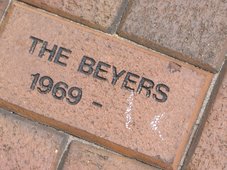Tuesday, May 13, 2008
A Cross To Bear
Yet again, Columbia's ideals are the subject of news coverage. This time, WaPo weighs in on the debate over placing a 16-foot cross on a new church building for the St John's United congregation in Wilde Lake.
Some guardians of local tradition see the cross as a challenge to the core values of Columbia.
"I think it's just wrong," said Robert Tennenbaum, a planner and architect who helped design Wilde Lake. "This is Columbia -- you are talking about a special place."
Since the Wilde Lake Interfaith Center opened in 1970 with a feast of bread and honey, St. John United Church and St. John the Evangelist Roman Catholic Church have shared the discreet low building, which has no outer markings to distinguish it as a house of worship. But after several years of planning and fundraising, St. John United, a congregation that melds Methodist and Presbyterian traditions, is expanding to provide more room for its flock.
The Rev. R. Whitfield "Whitty" Bass, pastor of St. John United, said he doesn't see why anyone would be offended by a cross on the exterior of a building. "The cross is a symbol of freedom," he said.
But others feel just as strongly that the cross will be an offense to the idea of interfaith centers as sanctuaries of inclusion.
"A number of people are really disturbed about it," said Rhoda Toback, a village resident and former member of the Wilde Lake Village Board.
The Wilde Lake Interfaith Center used to be home to other denominations, some of whom outgrew the space. There was a time when Jews, Catholics and Lutherans walked into the building together to worship in their separate places. Folks have debated the merits of the interfaith concept over the years.
Indeed, here's an excerpt from a 1999 WaPo story:
Enthusiasm for Rouse's vision seems to "go in cycles," said Linda Beanblossom, building manager for the Oakland Mills center.
As the leadership of a religious group changes or when a new group replaces an older one, she said, adherence to Rouse's ideas "does not necessarily carry through."
The Rev. Richard H. Tillman, pastor of St. John the Evangelist Catholic parish, which holds services at both Wilde Lake and Oakland Mills, acknowledged that the interfaith concept "does not resonate with everyone." There are those, he said, who believe a separate, identifiable building with its own distinctive character promotes a greater sense of community and loyalty.
But, Tillman added, "a living, breathing community whose members establish their identity . . . by treating each other with love and respect is much more potent than edifices or material constructs."
Some guardians of local tradition see the cross as a challenge to the core values of Columbia.
"I think it's just wrong," said Robert Tennenbaum, a planner and architect who helped design Wilde Lake. "This is Columbia -- you are talking about a special place."
Since the Wilde Lake Interfaith Center opened in 1970 with a feast of bread and honey, St. John United Church and St. John the Evangelist Roman Catholic Church have shared the discreet low building, which has no outer markings to distinguish it as a house of worship. But after several years of planning and fundraising, St. John United, a congregation that melds Methodist and Presbyterian traditions, is expanding to provide more room for its flock.
The Rev. R. Whitfield "Whitty" Bass, pastor of St. John United, said he doesn't see why anyone would be offended by a cross on the exterior of a building. "The cross is a symbol of freedom," he said.
But others feel just as strongly that the cross will be an offense to the idea of interfaith centers as sanctuaries of inclusion.
"A number of people are really disturbed about it," said Rhoda Toback, a village resident and former member of the Wilde Lake Village Board.
The Wilde Lake Interfaith Center used to be home to other denominations, some of whom outgrew the space. There was a time when Jews, Catholics and Lutherans walked into the building together to worship in their separate places. Folks have debated the merits of the interfaith concept over the years.
Indeed, here's an excerpt from a 1999 WaPo story:
Enthusiasm for Rouse's vision seems to "go in cycles," said Linda Beanblossom, building manager for the Oakland Mills center.
As the leadership of a religious group changes or when a new group replaces an older one, she said, adherence to Rouse's ideas "does not necessarily carry through."
The Rev. Richard H. Tillman, pastor of St. John the Evangelist Catholic parish, which holds services at both Wilde Lake and Oakland Mills, acknowledged that the interfaith concept "does not resonate with everyone." There are those, he said, who believe a separate, identifiable building with its own distinctive character promotes a greater sense of community and loyalty.
But, Tillman added, "a living, breathing community whose members establish their identity . . . by treating each other with love and respect is much more potent than edifices or material constructs."
Subscribe to:
Post Comments (Atom)





1 comment:
I definitely don't see how they can call it an Interfaith Center and then not respect the openness of that given name. Shouldn't they then put up a Buddha statue and also post the Wiccan Rede somewhere in front of the building? Some people belong to other faiths because of terrible past experiences with the Christian faith during their childhood (like my mother). I'm not saying it's wrong or right. It's certainly a major religion in our country and tied in to the birth of our nation. But, this is supposed to be a place that doesn't define those who seek to embrace their own personal brand of religion within? Correct?
Post a Comment